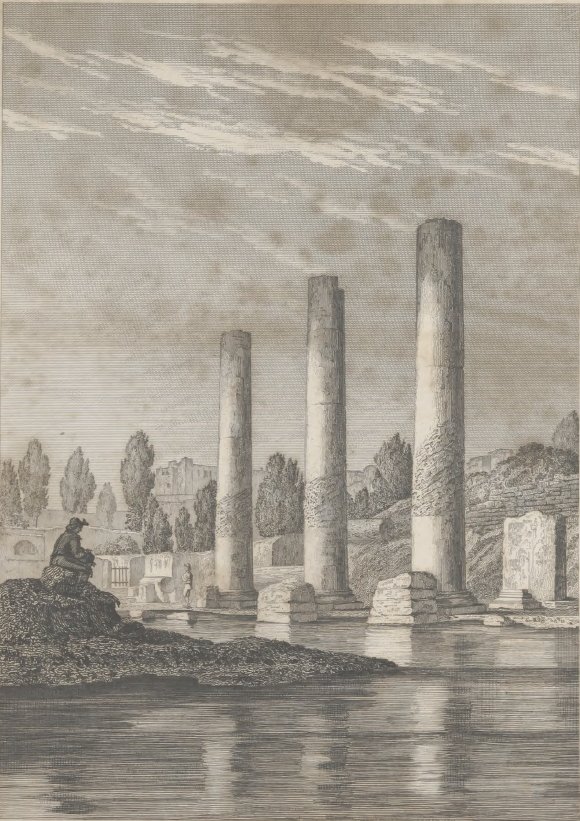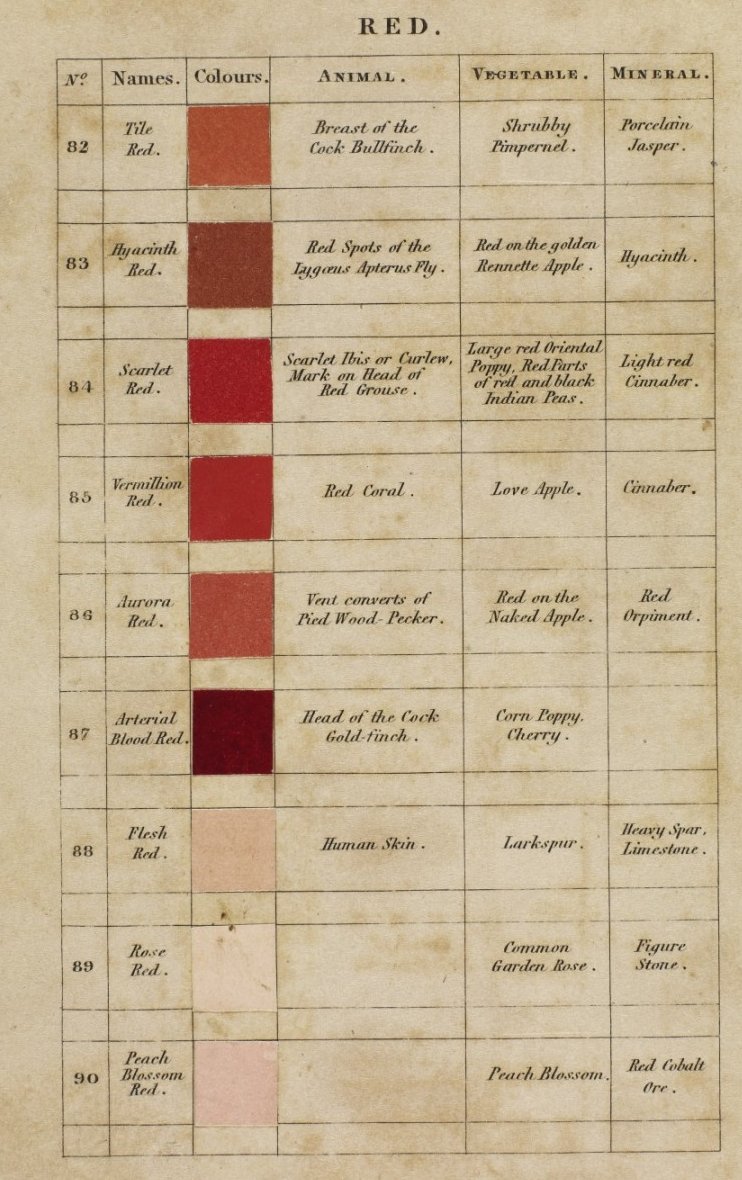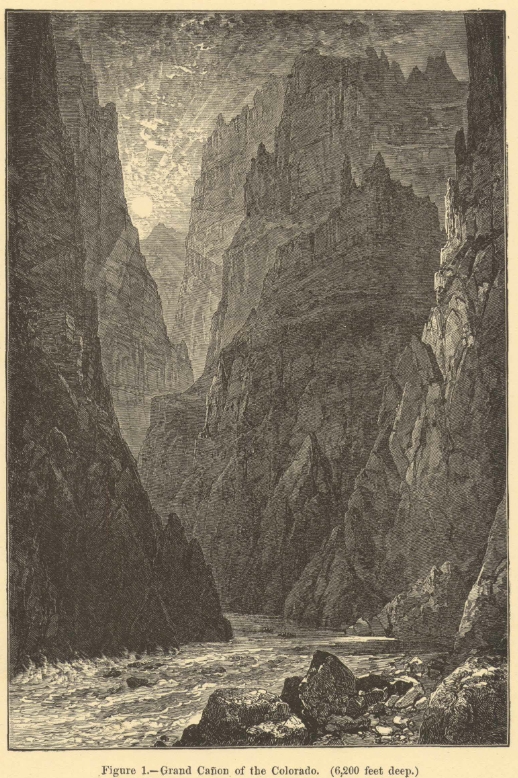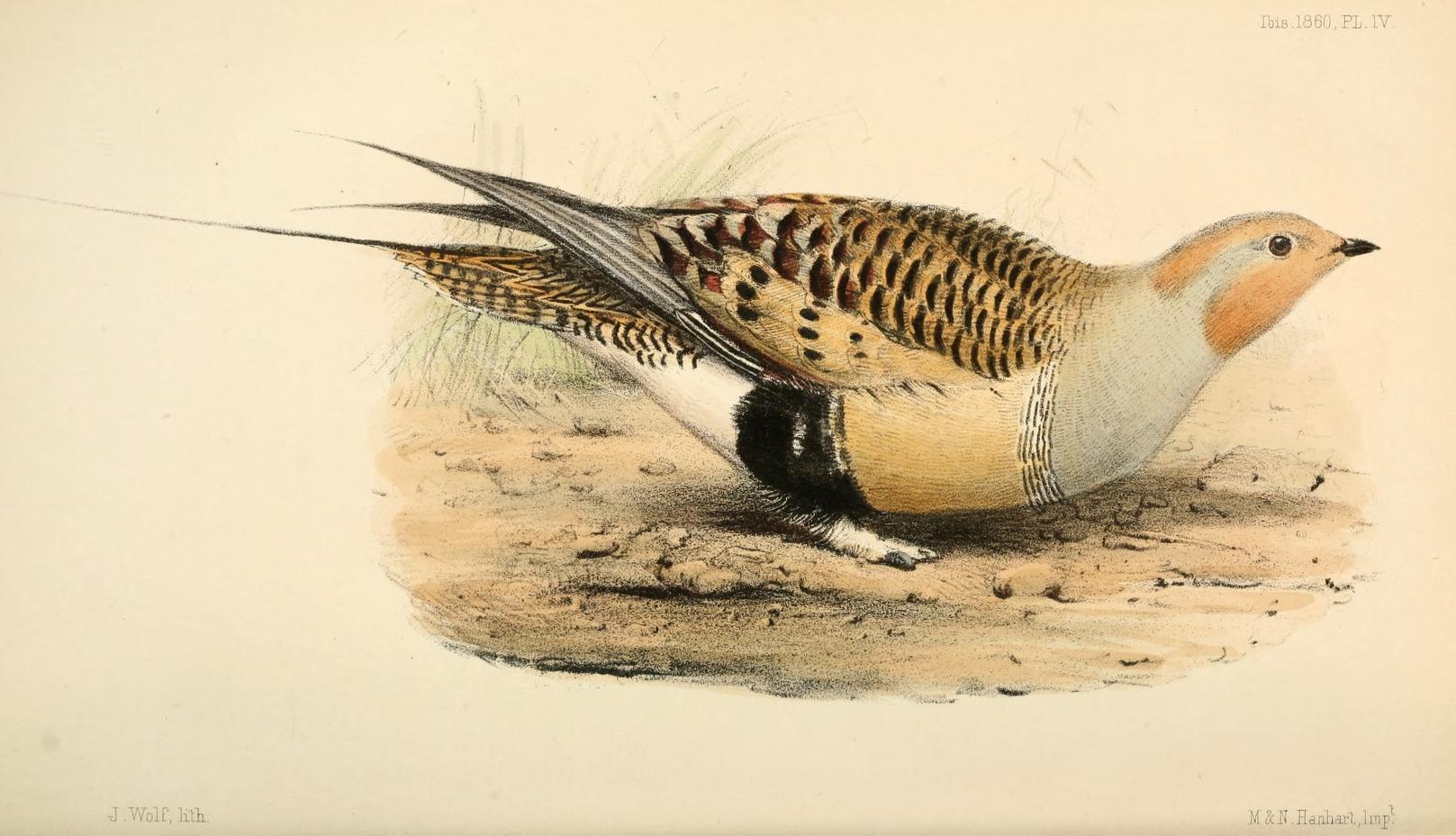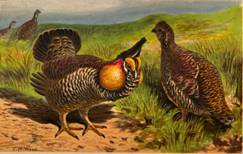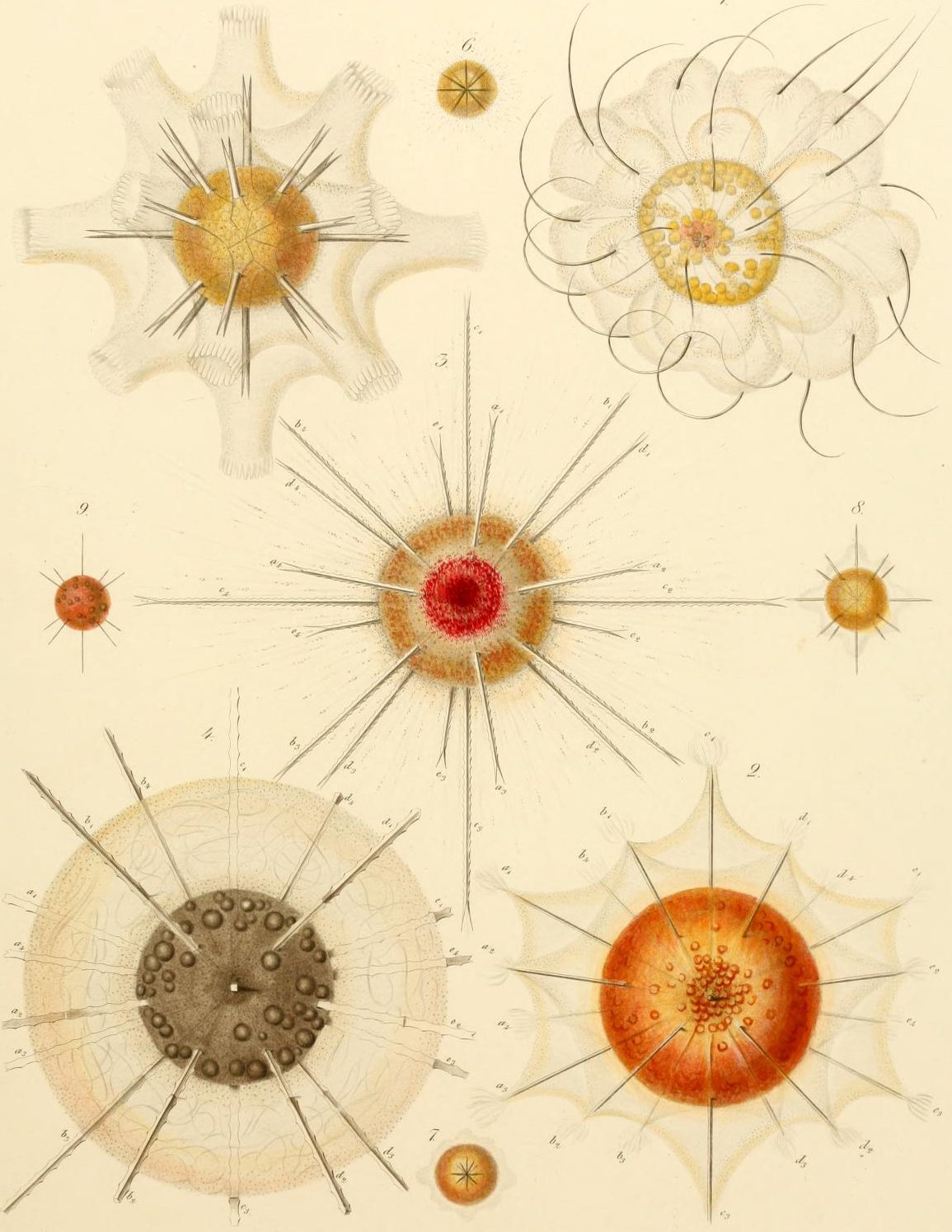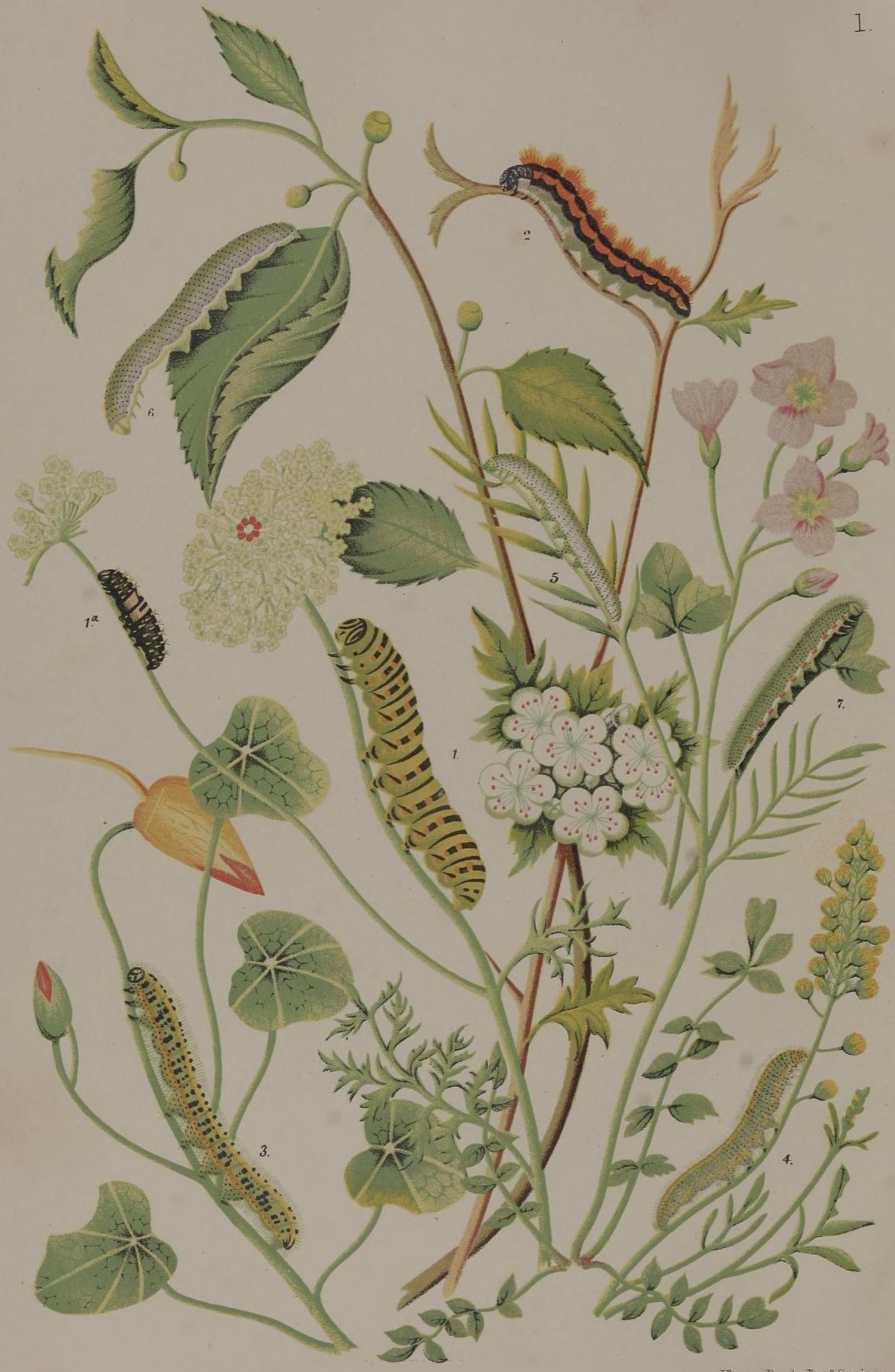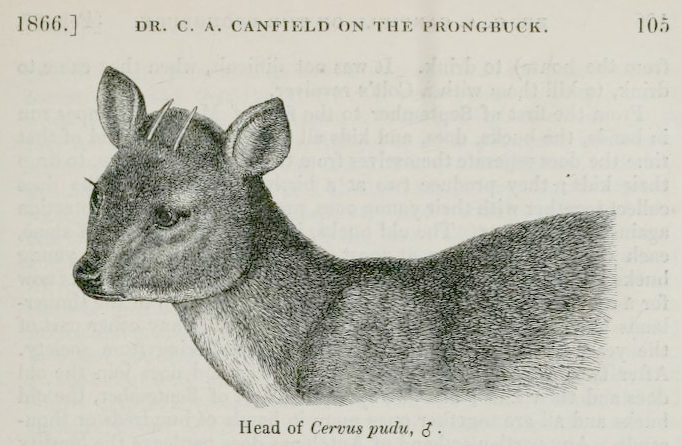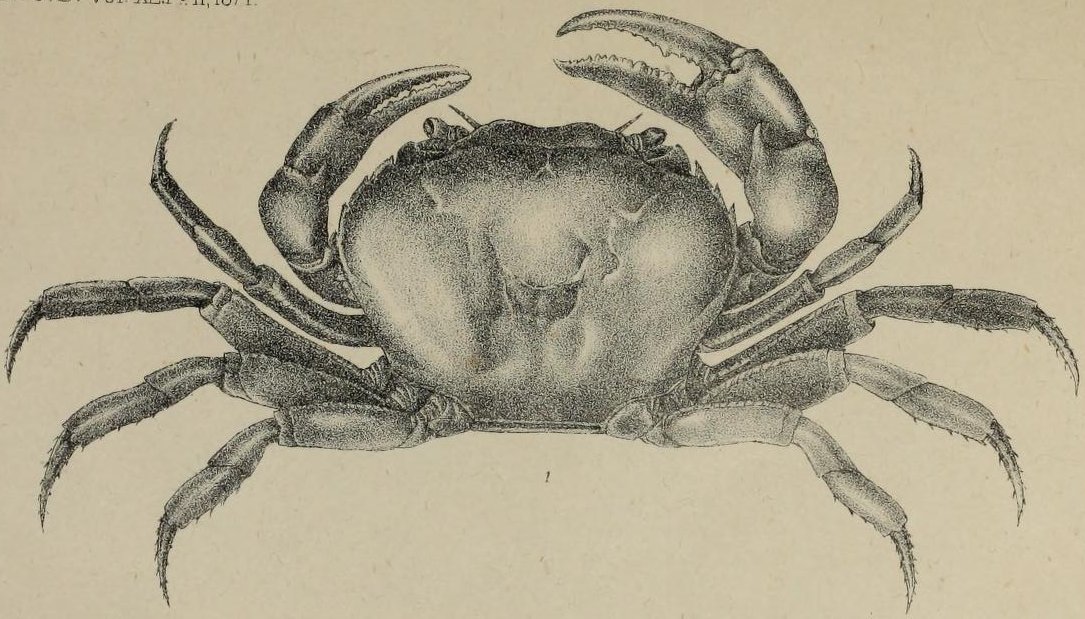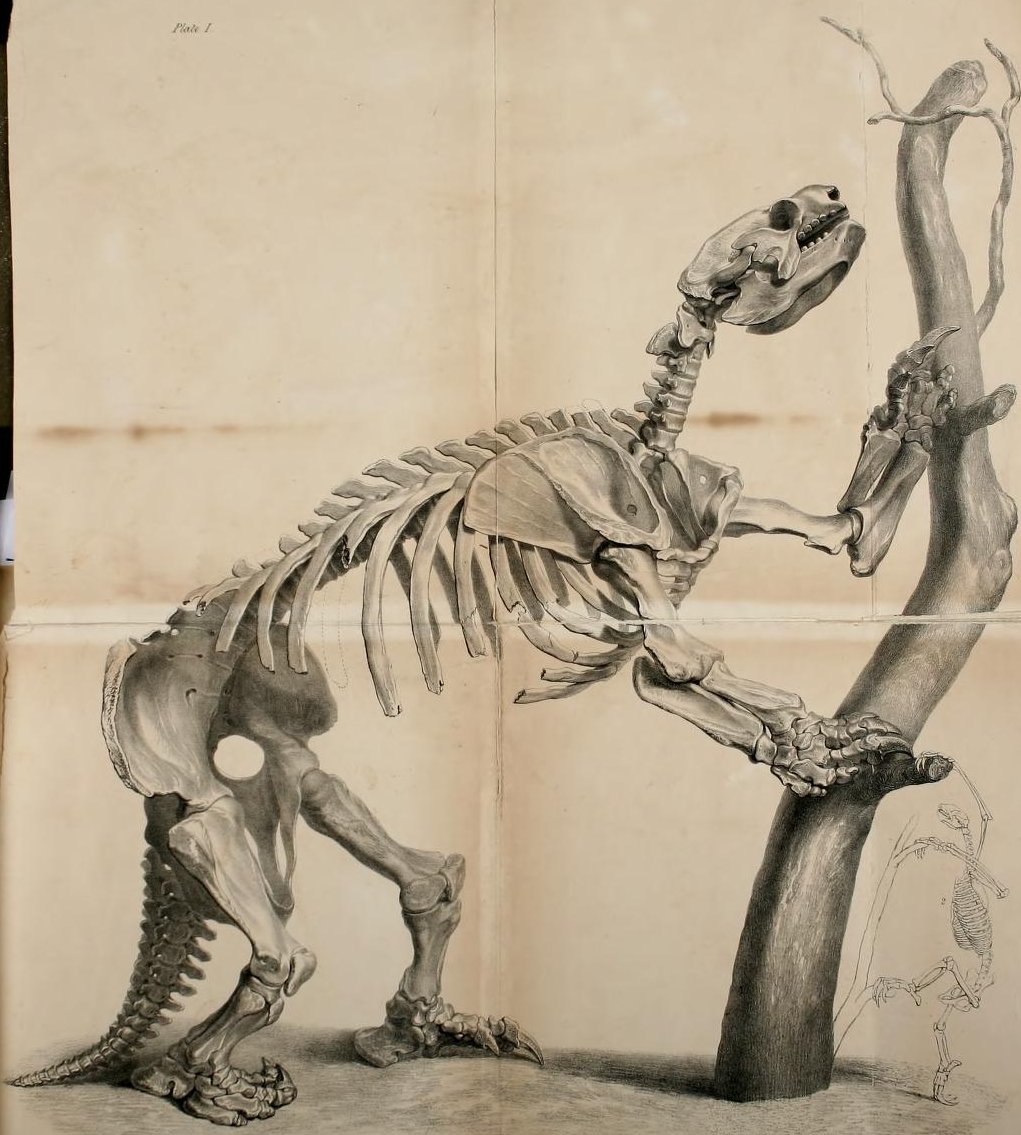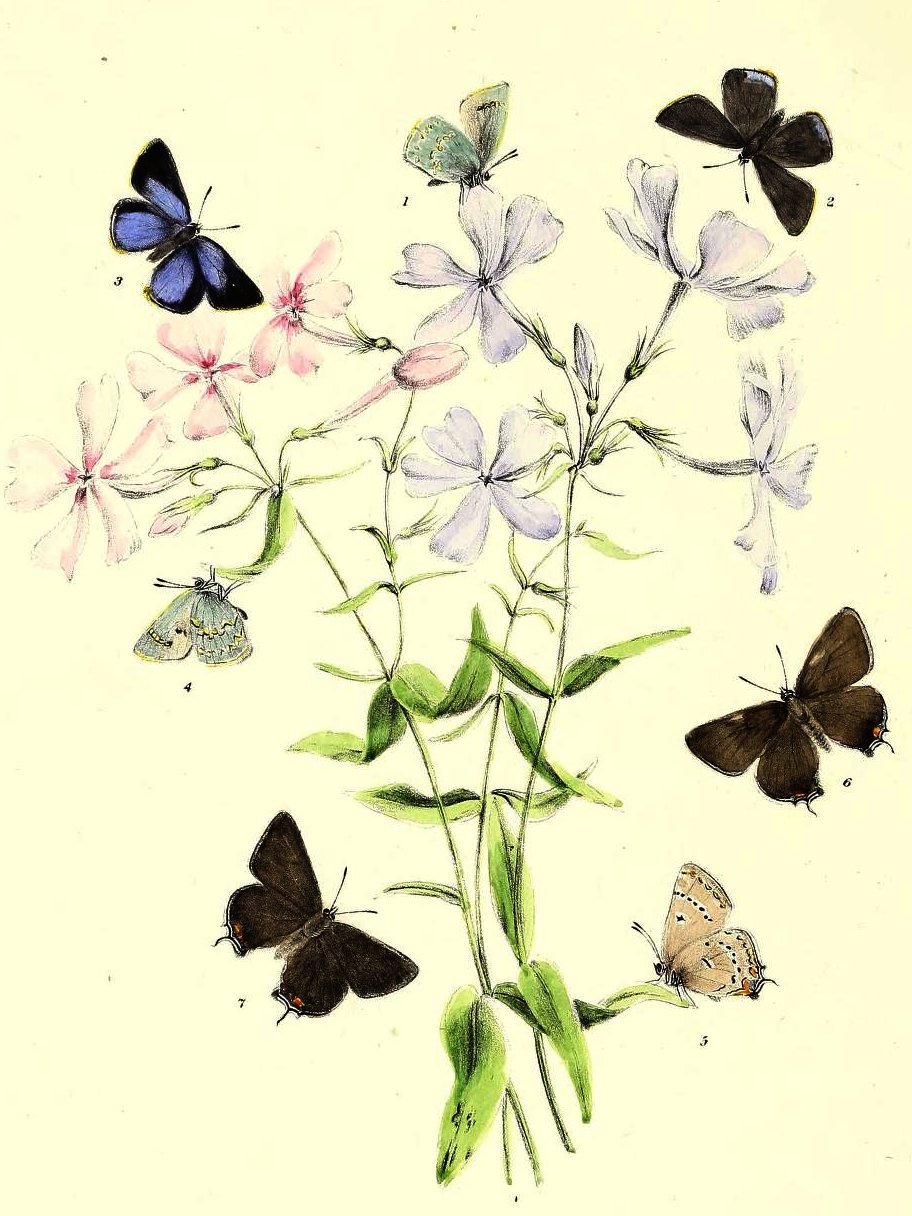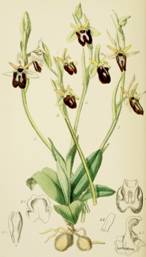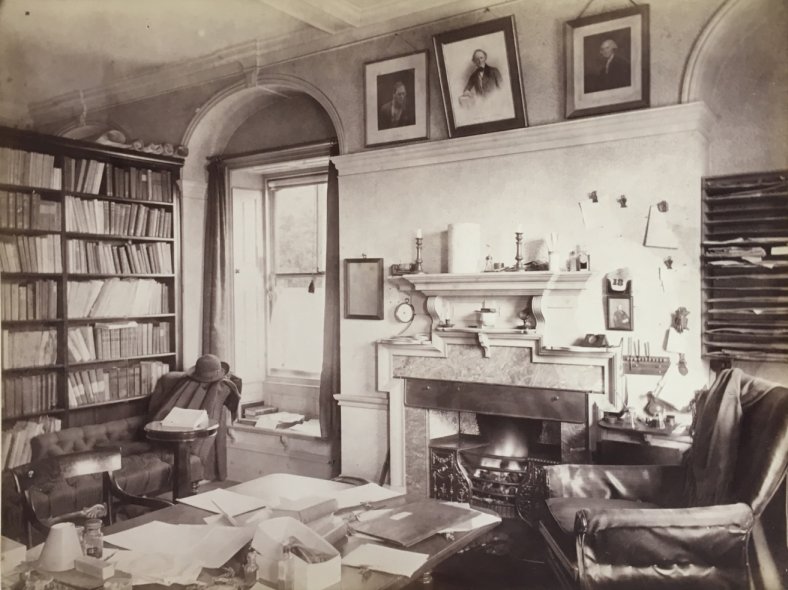
The Complete Library of Charles Darwin
Introduction by John van Wyhe
"I have bought many books…"
Darwin, Autobiography, p. 137.
View the Library
Charles Darwin's vast personal library, which he used to create his world-changing scientific works, was gradually dispersed after his death in 1882. Many of the scientific works were preserved and catalogued but many other items were not. Some were lost and details of the majority of the contents were never published- until now. Thus, for many years scholars have referred to Darwin's library as containing 1,480 books because that is how many were known to survive in the two main collections, Cambridge University Library and Down House. We can now reveal that this was only 15% of the titles in Darwin's library.
This is the first reconstruction of Darwin's complete library. The result of work on the Darwin Online project over 18 years and building on the work of many scholars, the list here details 8,900 titles across 14,000 volumes/items.
And, for the first time since Darwin's death, his library has been re-constructed, allowing anyone to discover the works Darwin owned, used and cited. The result is an indispensible tool for scholars, scientists, students and the history of Victorian science. Darwin's library is revealed as one of the most extensive and important private scientific libraries of the 19th century.
An all too brief summary
Darwin's library was so vast that our annotated catalogue of it is over 640 pages long. But this is far more than a catalogue. In addition to combining clues from scattered sources and piecing together thousands of fragmentary references, we have also digitised thousands of them and painstakingly created PDFs of multi-part articles, added higher quality illustrations and maps, re-created obscure pamphlets and provided over 14,000 links to electronic copies of the works. 9,300 are links to materials in Darwin Online, including 965 fully transcribed texts, and 4,900 are links to online copies of publications.
This unprecedentedly detailed view of Darwin's rich and complex library allows one to appreciate more than ever that Darwin was not an isolated figure working alone but rather built on the sophisticated science and other knowledge of thousands of people. Simply browsing through the list will give a modern reader an unprecedented sense of just how thorough, erudite and often quirky Darwin's interests and sources were.
Most of the works in the Darwin Library are, unsurprisingly, on scientific subjects, especially biological and geological. Many others are works on farming, animal breeding and behaviour, geographical distribution, philosophy, psychology, religion, and other topics that interested Darwin such as history, travel and language. Most of the works are in English, but almost half are in other languages, especially German, French and Italian as well as Dutch, Danish, Hungarian, Spanish, Swedish and Latin. With its millions of pages and tens of thousands of illustrations this new Darwin resource is unprecedented.
A few of the surprises in the library
As there are literally thousands of works revealed for the first time in this catalogue, only a handful can be mentioned here. Previously, no works by the famous philosophers John Stuart Mill and Auguste Comte were known in Darwin's library, now there are several. (see link & PDF) Nor was there any record of Darwin owning a work by the great polymath Charles Babbage. (PDF and link) Darwin had the Memoir of the brother of Robert Chambers, the secret author of the popular (pre-Darwin) evolution sensation Vestiges of creation (1844). (link)
It was not known that the Darwins purchased a copy of the infamous popular science book on gorillas that was all the rage just after Origin of species was published: Paul Du Chaillu's Explorations and adventures in equatorial Africa. (link) One of the very many shorter items in the pamphlet collection is an article entitled 'The hateful or Colorado grasshopper.' (link) There are also articles in Darwin's papers with the alarming titles such as 'The anatomy of a four-legged chicken' (Image) and 'Epileptic guinea-pigs'. (Image)
Many of the works that were not preserved with the part of the scientific library after Darwin's death were more ephemeral matter such as catalogues, items of personal interest, on health, social issues, or the fringe ideas of enthusiasts who sent their publications to Darwin. These items are in some ways now more interesting to historians than more formal scientific publications.
For example, there was a sumptuous 1872 coffee table book: Sun pictures: a series of twenty heliotype illustrations of ancient and modern art (link) that gives a sense of the Darwins enjoying art at home and a mundane 1832 road atlas of England and Wales (link).
Darwin's devotion to the 'water cure' for his ill health is well known, but we did not have a record of Dr Gully's book on the shelves: The water cure in chronic disease: an exposition of the causes, progress, and terminations of various chronic diseases of the digestive organs, lungs, nerves, limbs, and skin, and of their treatment by water and other hygienic means (PDF). Unsurprisingly, for a man who took such assiduous care of his finances, Darwin had a book on this too: Ward, A treatise on investments (1852 link)
Many of the works that were not handed over to Cambridge in 1908 are the oldest, what would have been rare books at the time. This might be why they were retained by the family and some later sold. These include more surprises.
Edmund Gibson, 1692. Chronicon Saxonicum. PDF
Johann Bauhin, 1651. Historia plantarvm vniversalis. PDF
Joseph Butler, 1736. The analogy of religion, natural and revealed. PDF
Maria Elizabeth Jackson, 1797. Botanical dialogues, between Hortensia and her four children. link
Thomas Burnet, 1684. The theory of the earth. PDF
Illustrations in the Darwin Library
Darwin's Library contains tens of thousands of diverse illustrations. No sample can be representative, but some are given below.
|
|
|
Frontispiece to Lyell's Principles of geology, the so-called Temple of Serapis. |
A page from Werner's nomenclature of colours. |
The Grand Canyon from Powell's 1875. Exploration of the Colorado River. link |
One of the most important works for Darwin's scientific development and theories was Charles Lyell's Principles of geology (1830-33).
A charming book Darwin took on the voyage of the Beagle to record the colours of specimens was Werner's Nomenclature of colours (1821) by the Scottish flower painter Patrick Syme. The book contains a set of named samples. Darwin's children later played with it to match and name colours.
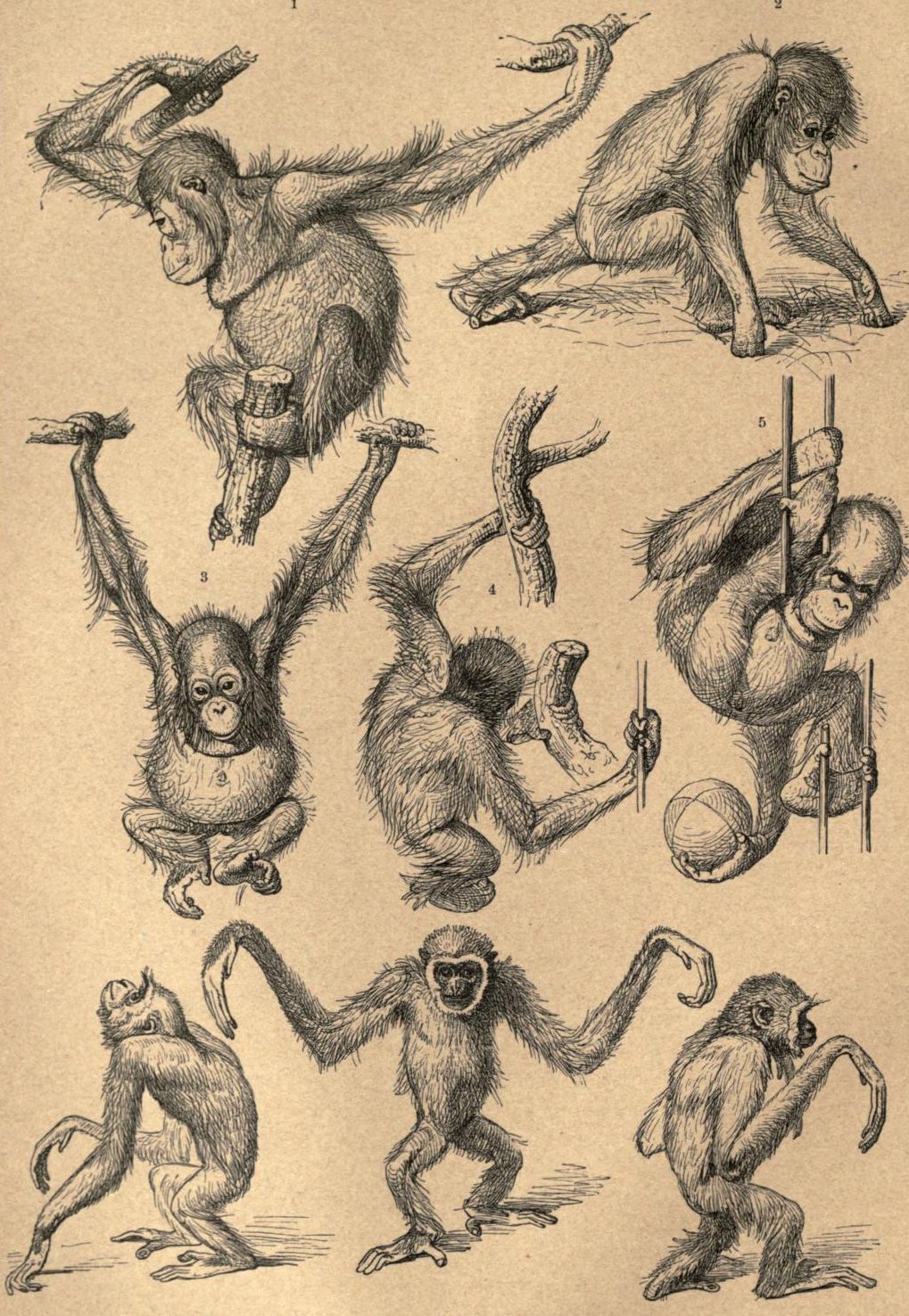 |
 |
The postures of orangutans and gibbons from Brehms Thierleben (link) |
Morren's 1867 illustration of Kerria japonica or 'Japanese rose' (link) |
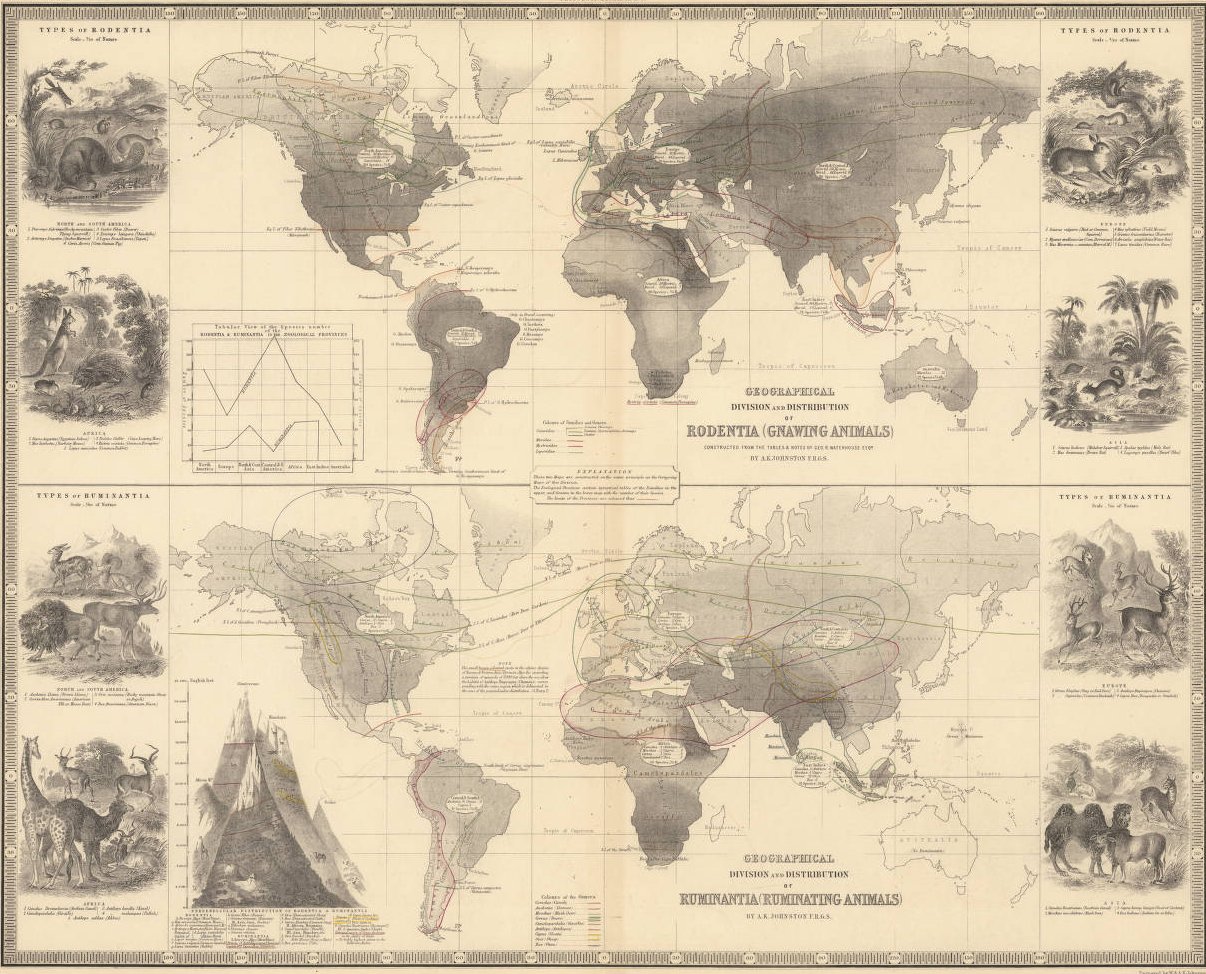 |
| Table of 'Zoological geography' by Waterhouse (link) In Darwin's enormous pamphlet collection is this 1856 table of 'Zoological geography' by the naturalist George Robert Waterhouse showing how particular animal types are found only in certain ranges of zone. This is now called biogeography. |
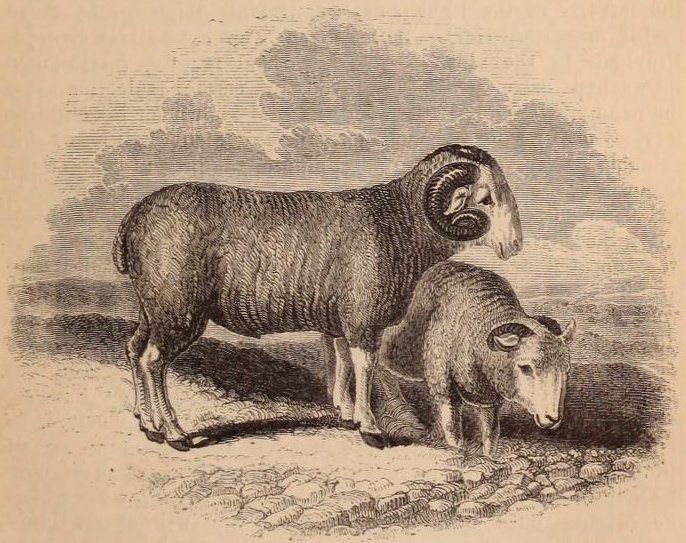 |
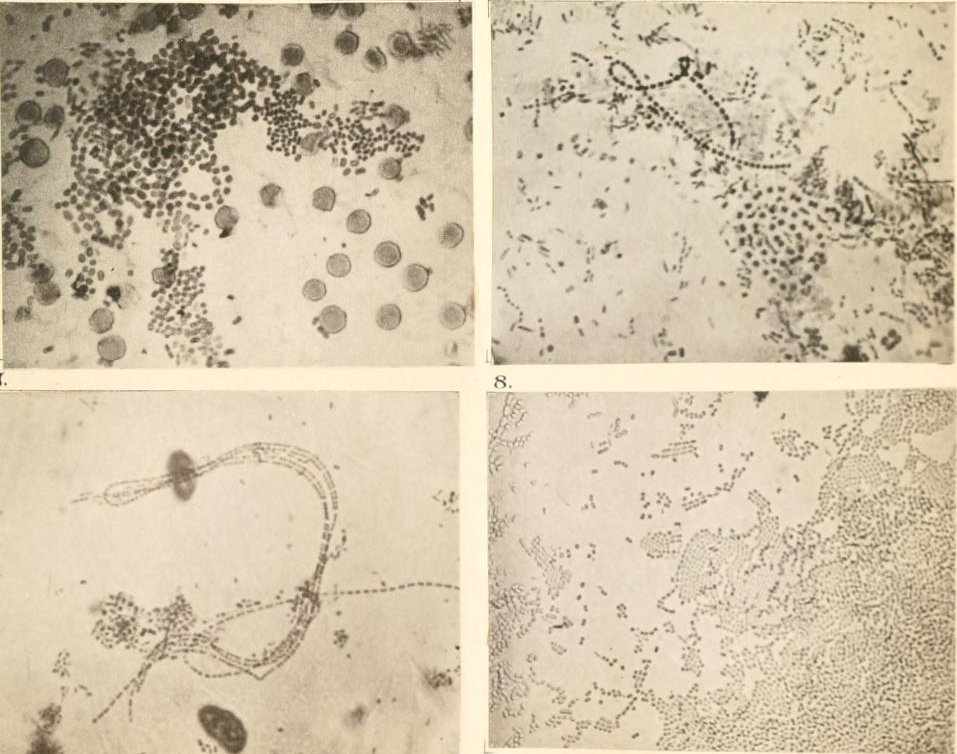 |
 |
The Old Wiltshire Sheep from Spooner, 'On cross-breeding', 1859. (link) Darwin cited Spooner in Variation. |
Darwin was sent an 1877 article by Robert Koch with the first published photographs of bacteria. (xiv, xv, xvi) |
|
|
The Sand-grouse from an 1860 article by T. J. Moore that Darwin preserved. (pl. IV) |
|
|
|
Ernst Haeckel's striking 1862 drawings of Radiolaria- a type of plankton. (link) |
Wilson's, The larvae of the British Lepidoptera and their food plants, 1877. (link) |
E. P. Wright's 1870. Notes on sponges. (1, 2, 3) Darwin's interests spanned the entire spectrum of life on Earth. |
|
|
A jaguar from Azara's Voyages dans l'Amérique Méridionale, 1809. The animals of the Americas were found to be quite distinct from those of the Old World. |
Canfield, 1866. On the habits of the prongbuck…and the periodical shedding of its horns. (link) Darwin cited Canfield in Descent 2d ed., p. 504. |
|
|
J. Wood-Mason's 1871. Contributions to Indian carcinology. (xi, xii, xiii, xiv-xiv, xxvii-xxvii) |
The Web-footed marsh rat from South America. Waterhouse published Darwin's mammal specimens from Beagle voyage. (link) |
|
|
|
Skeleton of the extinct giant Mylodon, discovered by Darwin, reconstructed and illustrated by |
Edwards, 1878. The butterflies of North America. (link) |
Moggridge's Contributions to the flora of Mentone. (xliii xliv xlv) |
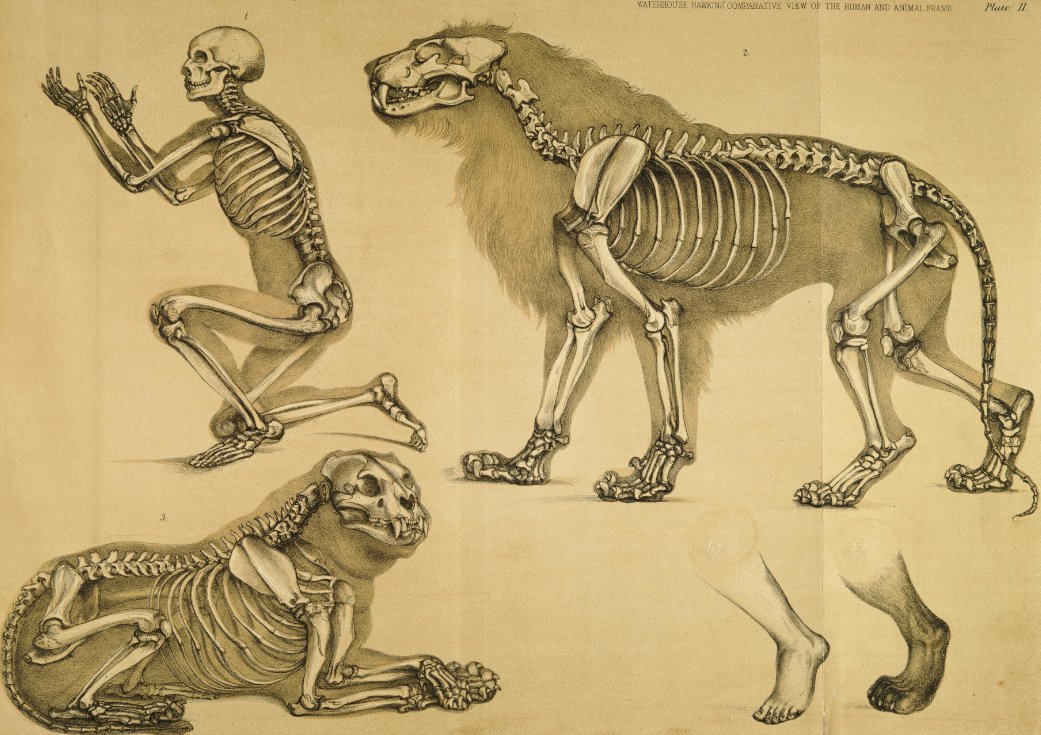 |
| Benjamin Waterhouse Hawkins, A comparative view of the human and animal frame, 1860. (PDF) |
The Library in Down House
The library was centred in Darwin's study where he worked and wrote his publications. The appearance of the Old Study is familiar from a c.1876 photograph by his son Leonard which has appeared in many publications. (below left) In the mirror on the mantelpiece one can see part of the bookcase on the back wall. Not visible is another bookcase on the left.
 |
|
| The Old Study c.1876. | The New Study in 1882. |
In 1877 an addition was built on the west end of Down House for a billiard room, bedroom and small drawing room. The ground floor room would become Darwin's New Study (today a gift shop). This room was left undisturbed for a few years after Darwin's death and its appearance is the best preserved by photographs and artworks. A week after Darwin's death, the family commissioned a copperplate etching by Axel H. Haig. (here)
Despite his frequent ill health, Darwin was a voracious reader and a voracious 'orderer' of publications he heard about or saw advertised. His home was packed with books, runs of scientific journals, pamphlets and cuttings that he snipped out of magazines, catalogues and newspapers if there was information relevant to his scientific research. He organized his papers surprisingly well but there were certainly other publications that remain to be discovered and added to the list here.
One might well wonder where Darwin kept such a large library as revealed here since there was not enough space along the two walls of the room. The answer comes with a closer look at the original layout and some obscure sources. For example, there are two bookcases, one in front of the other, on the left of Haig's etching. (here)
The 1882 photograph of the New Study by William England is from the same perspective but does not show the end of the bookcase. (above right) If one looks carefully at both images, the bookcase near the window is not backed against the wall but between two arched niches. Behind the front bookcase is another one lining the wall behind it.
One of the last photographs was taken in 1892 and published as an engraving in 1893. (below left) Uniquely, it shows the back wall of the New Study which was covered by a bookcase that extends above the door. On the right one can see the end of the back bookcase that was against the south wall. This was the last time the Darwin Library would be captured in its original state. (All the early depictions of Down House are listed in John van Wyhe's iconography in Darwin: A Companion, pp. 227-232.)

Darwin's Library after his death. Left. The only view of the back wall of Darwin's study, from an 1892 photograph by C. E. Corke. Right. Haig's etching (cropped). By stitching these two together, we can see most of the library shelves in Darwin's New Study. There were many other bookcases throughout the house.
Louise Buob, a former governess and schoolmistress for the Darwins in the 1860s, described the Library as "spilling over [from the study] into the hall and corridors, whose walls are covered with books…situated on the ground floor". (link) A journalist who visited Down House after Darwin's death described the New Study: "Two walls have shelves filled with books in every variety of binding, many of them bearing evidence of much use. Another bookcase is placed so as to form a sort of screen to keep off draughts, for Mr. Darwin, being always delicate in health, was very sensitive to cold." (link)
A neighbour, Wallis Nash, later recalled: "The walls were covered to the ceiling with well-worn books, which overflowed into the passages and landings on the upper floor. …Once, I remember, we were plagued in our grape forcing house by an invasion of 'mealy bug,' coming one knew not whence…I took a branch carrying a colony to. Mr. Darwin, telling him of our trouble. He studied it for a moment, and then turned to his son and collaborator, Frank, who was standing by. 'Go upstairs,' he said, 'and on the third shelf from the top of the left-hand bookcase, about the middle of the shelf, you will find the journal for 18— of such a German entomological society. About page 357, on the right of the book and midway down, I think you will find the description of the insect and its life history.' And there or thereabouts, we did find it." Walsh 1919
The French literary critic Francisque Sarcey visited Darwin in 1880 and Darwin showed him the study. In awe of the place where so many great scientific works had been written, Sarcey described it as "very simple and severe, this study, enlivened by the sun shedding its light over it in waves. The walls, from top to bottom, are concealed with books. Two book-cases, also occupy the middle of the study. One is full of volumes, and, on the other are arranged all sorts of scientific instruments." (Text) (See George Darwin's amusing recollection of Sarcey's visit here.)
In 1892, a decade after Darwin's death, the Rev. O. J. Vignoles visited Down House "which has now become classic ground as the scene of those meditations and experiments and profound generalisations which have built up the imperishable fame of Charles Darwin". Vignoles described Darwin's bookshelves in an article for the Christian magazine Good Words. They were not beautiful leather-bound volumes like a great country house he found, but plain, well-worn and often tatty paperbacks. It was clearly a library made for use, not for show. (Vignoles 1893)
After Darwin's death an inventory of Down House was made in May 1882, omitting things that were the property of Emma Darwin. In it we find the following books and bookcases listed:
Library (the New Study)
'2 Large grained skeleton bookcases'
'2 Sets japanned open bookcases'
'842 Vols bound books'
'Sundry unbound d° pamphlets'
'Family papers'
Billiard room
'15ft Maplewood bookcase upper part fitted shelves, pair of panel doors under'
Smoking room
15ft Maplewood bookcase upper part fitted shelves pair of panel doors under
About 710 bound books
Sundry unbound d°[books] etc
Drawing room
'8ft 6 Rosewood bookcase upper part fitted shelves, 4 doors under'
'6ft Cedar dwarf bookcase fitted shelves'
Entrance and inner hall
'6ft Cedarwood dwarf open bookcase'
'About 180 old Vols of books'
'3 Maps on rollers'
Landing and stairs to ground floor:
'2ft 6 Japanned tier bookcase'
'8ft 6 Polished deal open bookcase fitted shelves'
'243 Vols bound books
Sundry unbound d°[books] pamphlets'
Upstairs:
'6ft Walnut dwarf open bookcase'
No 4 Mr Darwin's Room & Dressing Closet
'Set of japanned 8 tier bookshelves
'40 Vols bound books'
'4 Folios containing Sundry maps &c.'
No 6 Room [a 2d floor bedroom]
'50 Vols bound books'
'Sundry unbound d°[books]'
A lifelong collection
The earliest of Darwin's books recorded here are from Darwin's time as a schoolboy at Shrewsbury school (his headmaster's Ancient geography Butler 1818 and a school prize: Oliver Goldsmith's A history of England (1821 link) Further works date to his time as a student at the universities of Edinburgh (Pharmacologia; comprehending the art of prescribing (1825 link) and Cambridge and those he took on the voyage of the Beagle. In 2014 the Darwin Online project extended the catalogue of known items in the Beagle library and digitized it in its entirety. The vast majority of Darwin's personal library dates to his life and scientific work after the voyage.
As large as his library was, Darwin read and consulted very many more works that he did not own. He made extensive use of libraries such the London Library and the libraries of the Linnean Society (link, link), the Geological Society of London (link), the Royal Geographical Society (link), or the Athenaeum Club (link). (These catalogues are some of the many works not previously known as part of his library.) Darwin also used the popular Mudie's lending library for much of his light reading. But what Darwin read is a separate question to what he owned.
Works borrowed or not owned by the Darwins are not recorded here. Many books were purchased by Emma and other family members. His son Francis contributed many works for his own research from the 1870s and after Darwin's death the 'scientific' library became his and many of the books now bear his bookplate. Rather than enter into subjective criteria about how much a book was or was not Darwin's, all of the printed works in the home for which evidence has been found will be considered here as part of the Darwin Library.
More detail
Discovering Darwin's library
The library list here does not follow the modern institutional and scholarly convention of distinguishing categorically between library and papers. During Darwin's lifetime it was a fluid whole. There are countless articles and even whole books in the Darwin Archive of manuscripts and private papers today.
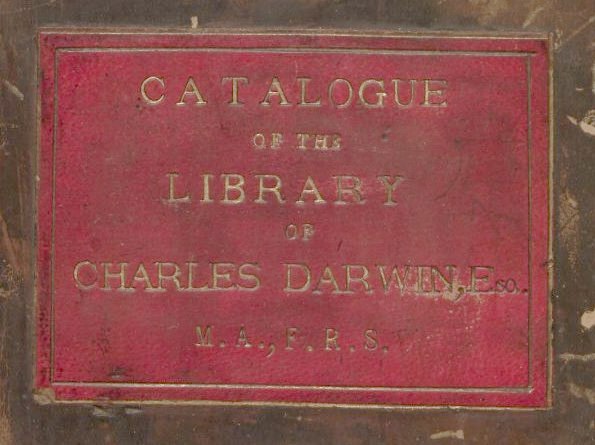
The label on the cover of 'Catalogue of the Library of Charles Darwin' Cambridge University Library (DAR240)
A crucial source for revealing the original contents of Darwin's complete library is the 426-page handwritten 'Catalogue of the Library of Charles Darwin' (CUL-DAR240) prepared for Darwin in 1875 and updated with new acquisitions thereafter. By comparing all of its often cryptic entries with the lists of surviving works, c.400 missing titles/items have been identified.
Darwin's son Francis gave most of the scientific books, pamphlets and journals to the Botany School in Cambridge in 1908 and a printed catalogue of the books was published. (1908 Catalogue) Comparing its entries revealed 18 items which seem to have gone missing over the years. Much of that collection was moved to Darwin's former home, Down House, after it became a public museum in 1929.
In later years there were several transfers of materials, especially items annotated by Darwin, to Cambridge University Library for the use of scholars. The editors of the Darwin Correspondence referred to these collections succinctly as the 'Darwin Library – CUL' and the 'Darwin Library – Down'.
Richest of all the sources are the original handwritten catalogues of Darwin's pamphlet and reviews collections (CUL-DAR252.1-5, CUL-DAR262.8.9-18 and abstracts CUL-DAR75). This enormous accumulation of printed materials, collectively called the pamphlet collection, was stored in 56 paper boxes when delivered to the Botany School in 1908. The catalogues used highly abbreviated references (such as author and a few title words) on strips of paper pasted alphabetically on a sheet of paper with gaps to allow for later additions. For example, one entry reads:

"374 Turner W. Brain of Chimpanzee"
The full reference in this catalogue is:
"Turner, William. 1866. Notes more especially on the bridging convolutions in the brain of the chimpanzee. Proceedings of the Royal Society of London 5: 578-587. PDF link"
Each one of these obscure records required its own detective story to discover the publication Darwin had noted as being in his library.
 |
| Part of the pamphlet collection and unbound items on the shelves at Down House museum in 1932. (Wellcome Collection) |
The 'General' pamphlet collection catalogue has 1,571 numbered entries, the 'Quarto' 336 and the 'Reviews [of Darwin's works]' 348. (Many items are not reviews of Darwin's books.) There are a mass of obscure entries and comments and some items were not recorded. Darwin's books and pamphlet records often indicate whether an item was '8vo' or '4to' (octavo or quarto) because size would often determine the shelf or bookcase where they were kept.
Francis Darwin recalled his father's manner of working:
He was methodical in his manner of reading books and pamphlets bearing on his own work. He had one shelf on which were piled up the books he had not yet read, and another to which they were transferred after having been read, and before being catalogued. He would often groan over his unread books, because there were so many which he knew he should never read… The books accumulated in the "read" heap until the shelves overflowed, and then, with much lamenting, a day was given up to the cataloguing. He disliked this work, and as the necessity of undertaking the work became imperative, would often say, in a voice of despair, "We really must do these books soon." Life and letters vol. 1, p. 151.
The pamphlet and reviews catalogues were first transcribed and the entries partially expanded by Darwin scholar Peter J. Vorzimmer in 1963. Darwin Online had the copy of Vorzimmer's catalogue of Darwin's "reprint collection" (Vorzimmer's term) in the Manuscripts Reading Room scanned and transcribed in 2008. More recently, J. David Archibald provided scans of Vorzimmer's own heavily annotated copy of the catalogue.
A vast amount of work on expanding and correcting Vorzimmer's and other references and identifying further works in Cambridge University Library was done by Kees Rookmaaker between 2007-2015. Nick Gill generously shared a database of references similar to Vorzimmer's lists in 2007 which was no doubt a Herculean labour and we are deeply indebted as indeed all who work in this area are. Like the 'Catalogue of the Library of Charles Darwin' (CUL-DAR240), many of the items in the pamphlet collection are now missing or have been moved.
What Darwin classed in his 'pamphlet' collection are not just pamphlets and offprints. There are very many thick volumes, even multi-volume works in it. Being classed as part of the pamphlet collection was likely a reference to binding, where the items were shelved or how he regarded them. These catalogues and other notes together provided about 2,800 references to printed items Darwin had in his library.
Other sources
Darwin's reading notebooks (CUL-DAR119 & CUL-DAR128) record the purchase of a few of the hundreds of works recorded there. He purchased a copy of Gérard 1844 on species, meaning he had three copies of this important pamphlet at one time. The two that survive were evidently given to him.
Emma Darwin sometimes noted down books to buy in her diary; 32 of these have been added here. Many more book titles in her diary do not have prices next to them. No doubt some of these too were purchased, but it is impossible to distinguish them from books she intended to borrow from a library.
After Darwin's death, an inventory of Down House was made to calculate Legacy Duty, omitting property of his wife Emma. In it we find 2,065 bound books counted around the house and an unknown number of unbound volumes, sundries and pamphlets. And, in a precious piece of good fortune, the books in the drawing room were listed. Little more than an author name and a few words of the title and the number of volumes was recorded. But it is enough to add 132 titles and 289 volumes of mostly unscientific literature to the Darwin library catalogue here.
The appraiser estimated that the "Scientific Library that is books relating to Science" was worth about £30.12.0. And all the books were valued at only £66.10.0. So much for the value of second-hand books at the time. Today any publication that belonged to Darwin is worth a great deal to collectors.
In 1899, after the death of Emma Darwin, other books from the Darwin library were given to Cambridge University Library. These included more literature and works on religion and some older works. A list was published in the Cambridge University Reporter in 1900 which we digitized in 2007. (Text) Also in 1899, Darwin's son George gave 76 volumes to the library of Newnham College, Cambridge. A very thoroughly researched list of these diverse works was prepared by librarian Deborah Hodder in 2011 and we are very grateful to be able to add the titles here.
Francis Darwin gave a few books that belonged to his father and himself to Christ's College Library, including Robert Proctor's 1825 Narrative of a journey across the Cordillera of the Andes. Darwin's copy is digitized only in Darwin Online: (Image/PDF)

Darwin's signature on the inside front cover of Proctor 1825.
Printed sources with further clues about the contents and history of Darwin's library were also consulted and, like other materials, reproduced in their entirety in Darwin Online so that they can be used by anyone. These include:
1960. Handlist of Darwin papers at the University Library Cambridge. Text PDF
1961. Darwin library: list of books received in the University Library Cambridge March-May 1961. [Annotated copy in CUL Manuscripts Reading Room, kindly provided by Frank Bowles.] Text PDF
After the 1960 Handlist was published, the full contents of Darwin's private papers remained inaccessible to all but the initiated few who spent time at Cambridge University Library. A detailed item-by-item catalogue of the Darwin Archive was prepared by Nick Gill in the early 2000s. For years this was available only as a printout in the Manuscripts Reading Room.
With the kind permission of the Syndics of Cambridge University Library and helpful guidance from Gill, the Darwin Online project first digitized and made this invaluable catalogue available online in 2006 as the core of the Darwin Online Manuscript Catalogue, the first and largest union catalogue of Darwin's manuscripts and private papers in the world.
It now records Darwin items in more than 80 institutions and private collections. This catalogue makes it possible to instantly search for all the printed items in Darwin's papers, which comes to 3,277 (excluding posthumous items in the collections). But only 1,400 of these have been included in the lbrary lists here. We have corrected and revised thousands of records since 2006 by identifying the sources of clippings, dates, authors and information discovered by the editors of the Correspondence of Charles Darwin.
We owe a very great debt to the kind and generous help of Adam Perkins, former Curator of Scientific Manuscripts at Cambridge University Library. Adam cheerfully provided copies of and permission to use some crucial documents. Foremost of all were his Excel lists of the then known contents of the Darwin library in Cambridge (710) and Down (810 items). Adam also shared and Excel sheet of the 1899 Emma Darwin bequest with CUL class marks and the list of Darwin's personal copies of his own books that were purchased by Cambridge University Library from great-grandson Robin Darwin in 1962. (classed as CUL-CCA.24)
We were also provided with copies of the catalogue of Darwin's 'Unbound material' by Nick Gill (1703 items with class marks U1-U1703). Adam Perksin also shared further information from his work in the archives over many years. We are heavily indebted to the staff of the Manuscripts Reading Room at Cambridge University Library (past and present), especially Godfrey Waller, for assistance with all of these and many other documents and queries. More recently, Liz Smith very helpfully shared a newer list of 820 of the Darwin books in Cambridge University Library with a new class of numbers, 'Dar Lib'. These are cited in the catalogue here along with older numbers which allows for the movements of the books over time to be traced.
Another invaluable source for finding works originally in Darwin's Library is his correspondence. The thirty volumes of the Correspondence of Charles Darwin (1985-2023) reveal many items that were sent to Darwin or which he ordered- but are not now found in the surviving collections. The Correspondence also records many additional items in Darwin's pamphlet collection that were not present in the other lists and catalogues we have used here.
Other works have been made known to us by owners of private collections. It is from one such collection in Virginia, USA, that we are able to provide scans of some of Darwin's copies of two of his most important books, Origin of species (1859 Image PDF) and Descent of man (1871 vol. 1 Image PDF vol. 2 Image PDF)
 |
 |
| Title pages of Darwin's copies of Origin of species and Descent of man. The numbers on the top right corners correspond to the Darwin family catalogue (CUL-DAR240). Physically these three volumes are now far apart but in Darwin Online, their original relationship is restored. |
|
And finally, a thorough investigation of historic auction and rare book catalogues by John van Wyhe has revealed works from Darwin's library that have appeared in the trade since the first one found, a book on chess that sold in 1889. (link) Appearing for sale in 1916 and apparently never seen again and unknown in Darwin scholarship is Darwin's signed schoolboy copy of Homer's Iliad in Greek and Latin (1815).
Darwin also had a copy of an 1826 article by the great ornithologist John James Audubon which was previously unknown: 'Account of the habits of the Turkey Buzzard...exploding the opinion generally entertained of its extraordinary power of smelling.' (link) This appeared at auction in 1975. Darwin had investigated the subject during the voyage of the Beagle and recorded reading a critic of Audubon in the lost Galapagos notebook. In 2019 the Darwin family copy of Elizabeth Gaskell's 1880 novel Wives and daughters appeared at auction. A note in the book records: "This book was a great favourite of Charles Darwin's and the last book to be read aloud to him."
There are further works that belonged to Darwin and his family that remain to be recorded here. We would be grateful to hear from anyone with information about other works that can be reliably shown to have been in the Darwin Library.
More accurate
We have not only assembled titles and references from many sources, we have had to piece together what most of them referred to and checked and corrected earlier lists and references. Darwin often cut pieces out of publications without recording where they came from. Many of the printed items in the Darwin Archive were unidentified or the author, publication or date was unknown. We have identified the sources and added more complete details to thousands of these. A few examples are below.
Original record |
Revised record |
Anon. 1860s-1870s?. Map of Great Barrier Reef. [source unknown]: [1]. CUL-DAR69.A119. |
Dower, I. 1850. Chart of the northern part of the Great Barrier Reef including Torres Strait, & ye. adjacent coast of New Guinea. Reduced from the surveys made in H.M. ships Fly & Bramble 1842-5. London: T. & W. Boone. CUL-DAR69.A119. Image [link] |
Anon. 1861. The Field: 32 (part issue). |
Harvey, R. 1861. Nest of the missel-thrush. The Field (13 July): 32. CUL-DAR205.11.5-6. Image |
'Catalogue of floricultural seeds' [Nichols]: 12pp CUL-DAR46.2.A2. |
Cattell, John. 1855. Catalogue no. 2, descriptive of the fine collection of floricultural seeds, including assortments of very superior German stocks, asters, wallflowers &c., sold by John Cattell, Seed and Nursery Establishment, Westerham, Kent. London: Nichols and Son. CUL-DAR46.2.A2. Image |
"Shaw, James [1826-1898] Mental progress of animals `[source unknown]': [1] CUL-DAR205.11.50 |
Shaw, James. [1878]. Mental progress of animals. [from: Memoir on the mental progress of animals during the human period. Journal of the Royal Anthropological Institute 7: 96-99.] CUL-DAR205.11.50. Image [link] |
[undated] 'List of publications' [Reeve]: 21-22 CUL-DAR91.85. |
Reeves, William. 1858.11. Mr. Reeve's list of publications. London: Reeve, pp. 21-22 only [Advertising: Belcher, Zoology of the voyage of H.M.S. Samarang and Forbes, Zoology of the voyage of H.M.S. Herald]. CUL-DAR91.85. Image link |
[1846orafter] Watson, H. C. 'IV: Publications' (apparently an extract from his C.V) [private]: 47-50 CUL-DAR91.86-87 |
Watson, Hewett Cottrell. 1846. Testimonials in favour of H. C. Watson, as a candidate for a chair of botany in Ireland. London: Spottiswoode, pp. 47-50 only: "IV. Publications. 1. A list of works and some of the papers on botany and connected subjects, by Hewett C. Watson." CUL-DAR91.86-87. Images |
Clippings like these in Darwin's collection don't just show that Darwin had so many pieces of paper. Each one of them reveals a scientific journal issue, magazine or a newspaper that Darwin poured over for information about the natural world. What we see recorded are the items he chose to single out.
Some of the records in the older institutional lists, and published uncorrected by earlier projects, had errors such as incorrect authors, titles, dates and so forth. As just one example of many, this curious reference:
Müller, Hermann. 1879. Die Wechselbeziehungen zwischen Blumen und den ihre Kreuzung vermittlenden Insekten. Breslau: Trewendt. [Linnean Society of London].
This is a book that does not seem to exist as such. It is in fact:
Müller, Hermann. 1879. Die Wechselbeziehungen zwischen den Blumen und den ihre Kreuzung vermittelnden Insekten. (from: A. Schenks, Handbuch der Botanik, vol. 1. Breslau: Eduard Trewendt, pp. 1-107.) [Linnean Society of London, 581.16 MUE] link
One lesson that always needs to be re-learned is that checking a large work anew will always identify errors and allow for improvement.
Another project was published online in 2011 called 'Charles Darwin's Library'. That catalogue re-used the list of 1,476 known surviving books. Of these, 434 (in 542 volumes) which Darwin annotated were put online at the Biodiversity Heritage Library. (120 volumes are Darwin's personal copies.) These are enriched with Darwin's annotations copied from Charles Darwin's marginalia (1990) by Mario Di Gregorio and Nick Gill, with revisions. By 2011 our own list of the Darwin Library was already in the thousands, but we were unsure whether to continue given the hostility of the other project leader- who in addition to establishing a project that overlapped with the well-known Darwin Online, but spent years defaming the project and its director and falsely claiming to be the superior and legitimate Darwin mansucripts project and persuading individuals and insitutions to ignore Darwin Online and cite or co-operate with his project instead. But we feel our research will do more good if available freely to all rather than remaining any longer unpublished.
Anyone who compares the work published here with the bibliographies published by that other project in 2006 and 2011 will be in no doubt where the hard work has been done and which was a quick grab for attention never to be touched again.
The present catalogue is aimed at recreating the whole library as accurately as possible- whether Darwin bought, inherited or was sent a work unasked for.
Because Darwin's Library is now reunited with his publications, manuscripts and papers, it is possible to explore his citations of and notes on the works in the Darwin Library directly. By going to the Advanced Search page and entering an author's name, for example Yarrell, in the Full Text box at the top and hitting Enter, the following search results appear: Yarrell. Or the same for Cuvier. The search could be narrowed by searching for Cuvier and a word from the title of only one of his books, Kingdom: see "Cuvier Kingdom". These can be refined to search only manuscripts or only publications etc.
Further notes
The catalogue of the Complete Library of Charles Darwin is based on many sources and the work of many librarians, cataloguers and scholars. Many lists of printed items from Darwin's lifetime and since, were compared and collated. Tens of thousands of entries which were nearly identical were compared to identify missing and overlooked items or details. We therefore reluctantly had to remove the conventional square brackets around authors and dates not identified on the original items or when published anonymously and have only restored some of them.
Note that articles or other items in periodicals that have been transcribed or imaged separately in Darwin Online (for example because Darwin cited or used them extensively) are listed even if the whole issue of the journal in which they appear is listed separately
We have tried to follow the original wording and punctuation of the publications Darwin owned. Therefore we have not italicised the name of a species etc. if it was not so in the original publication. We have replaced ligature characters to help readers who will no doubt use search functions to find items in the list. In some cases there are double localities given for a work, such as 'Darwin Library-Down' and 'Darwin Library-CUL'. In many cases this is because the book was originally recorded as at Down House but was later moved to Cambridge. In a few cases there is a copy at both.
Abbreviations etc.
CCD: The Correspondence of Charles Darwin.
CUL: Cambridge University Library.
CUL-1899: The donation mostly recorded in: List of donations received during the year 1899: From the executors of the late Mrs Darwin. Cambridge University Reporter (15 June 1900). Text
CUL 1961: Darwin library: list of books received in the University Library Cambridge March-May 1961. Text PDF
DAR: The Darwin Archive, Cambridge University Library.
ed.: edition or editor.
ff.: and the following pages.
Inscribed: A work is inscribed to Darwin, such as "With compliments of the author". For books, in almost all cases this information is derived from Mario di Gregorio and Nick Gill's Marginalia (1990).
n.d.: no date.
pls.: plates (illustrations).
pseud.: Pseudonym.
Pt.: part (of a publication), sometimes equivalent to volume.
signed: A work bears Darwin's signature or autograph. For books, in almost all cases this information is derived from Mario di Gregorio and Nick Gill's Marginalia (1990).
[?]: It is uncertain if an item, or which edition, was in the library.
Acknowledgements
The Complete Library of Charles Darwin makes extensive use of work done since the beginning of the Darwin Online project- therefore the general acknowledgements already covers many who contributed to this work. Immense contributions were made by Kees Rookmaaker, not least of all his experience as a bibliographer. A vast amount of work by Christine Chua from transcribing, image preparation and renaming, catalogue and reference improvements and discoveries and much else has contributed very greatly to the library. Much work by Sue Asscher is also part of the complete Darwin library. Angus Carroll and J. David Archibald have also generously shared information and scans of publications in their collections.
At Cambridge University Library we are grateful for assistance from Adam Perkins, Frank Bowle, Godfrey Waller, Jill Whitlock, Liz Smith, Samantha Evans and Patrick Zutshi. We are indebted for assistance and permissions from the Syndics of Cambridge University Library, English Heritage (Darwin Collection at Down House), the Darwin, Barlow and Keynes families, the Master, Fellows and Scholars of Christ's College, Cambridge and Candace Guite, the University Museum of Zoology Cambridge, the Sedgwick Museum of Earth Sciences, the Royal College of Surgeons of England, the Darwin Heirlooms Trust, The Huntington Library, and the Linnean Society of London. Finally, we are most grateful to William Huxley Darwin for permission to reproduce Darwin's handwritten notes.
The original copies of Darwin's library items are held in Cambridge University Library, the Library of Plant Sciences, Cambridge, the Library of Earth Sciences, Cambridge, the Whipple Museum of the History of Science, Cambridge, the library of the Linnean Society of London, the library of the Royal Society of London, the library of Christ's College, Cambridge, the library of Newnham College, Cambridge, Down House (English Heritage), the Archives of University College, London, the Library of Shrewsbury School, Special Collections, University of Delaware Library and private collections. I am extremely grateful to Gordon Chancellor, Liz Smith and others who provided suggestions on earlier drafts of this introduction. Many thanks to Tessa Kilgarriff for sending details of a printed map on display in Darwin's study at Down House. Thanks to Patrizia Martellini for sending a rare Italian work. Joseph Arditti encouraged another look at a volume on orchids. Edwin Rose generously shared details of Darwin family books in his collection and others that he is aware of as well as photographs of Darwin marginalia hitherto unknown.
Although the lasting scholarly value is the catalogue itself of what was in Darwin's Library, making this accessible and readable online was made possible by online text collections which allow their work to be used in other projects, particularly Cambridge University Library, the Biodiversity Heritage Library (BHL), Google Books, the Wellcome Library, ANNO (AustriaN Newspaper Online), Österreichische Nationalbibliothek, the Münchener Digitalisierungszentrum of the Bayerische Staatsbibliothek, the Bibliothèque nationale de France (BnF), the Internet Archive and many others. Leonie Berwick and Will Beharrell looked for an obscure offprint in the Library of the Linnean Society of London. With thanks to Edward Beasley and Paolo Coccia for sending corrections.
RN21






